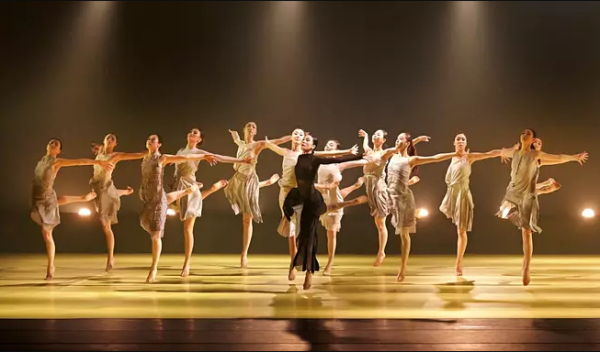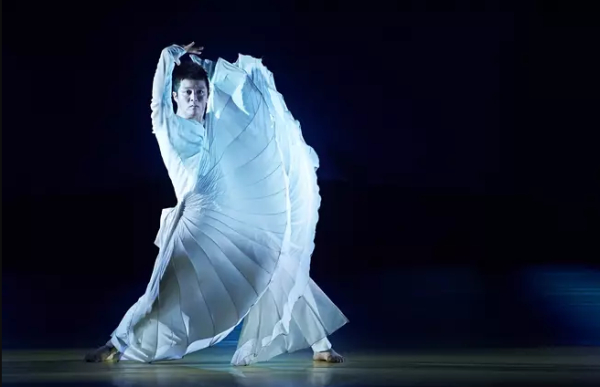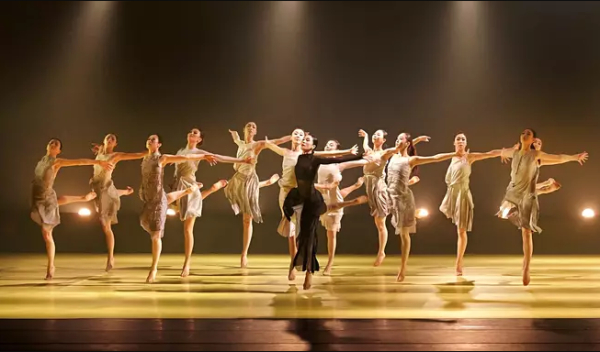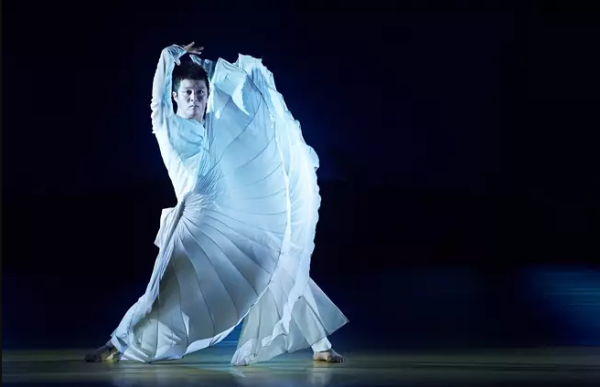[더프리뷰=서울] 편집자 = 지난 9월 22-24일 핀란드 헬싱키 댄스하우스에서 있었던 국립무용단 <회오리> 공연에 대한 현지 언론 Helsingin Sanomat의 리뷰를 번역, 게재한다. 1889년 헬싱키에서 창간된 이 신문은 독자 70만 명을 보유한 북유럽 최대의 신문이다.
필자: 유카 미에티넨(Jukka O. Miettinen)
원문에서 영문번역: 시모 바시넨(Simo Vassinen)
영문에서 한글번역: 김수인
국립무용단을 위한 테로 사리넨의 화려한 작품은 한국적 분위기를 물씬 풍긴다.
테로 사리넨의 <회오리>는 한국 국립무용단이 서양 안무가와 함께한 첫 작품이다.

제목 그대로 테로 사리넨의 안무 <회오리>는 관객을 수중 소용돌이의 깊이로 끌어들이는 것으로 시작한다. 국립무용단의 의뢰로 2014년 서울에서 초연된 이 작품은 이후 일본과 프랑스를 순회했다.
1시간 30분 분량의 거대한 작품은 전체 20인 앙상블의 군무가 주도한다. 이 순간들은 의례와 같은 집단정신을 이끈다. 무용수들은 무대 가장자리에 앉아 점점 더 가속화되는 이벤트에 합류하기를 기다리는 것 같다.
무대 건너편에는 네 명의 연주자 그룹이 앉아 있다. 감동적인 음악은 젊은 작곡가 장영규의 작품이다. 그는 다양한 음악 앙상블 뿐만 아니라 연극, 영화, 무용 등 다방면에서 활동해온 다재다능한 예술가이다.
라이브 연주자 4명은 타악기, 피리, 해금, 그리고 아마도 국제적으로 가장 친숙한 한국 악기인 가야금과 같은 전통악기를 연주한다.
판소리 전통을 따르는 표현적인 노래도 포함된다. 이 경우에는 가사가 없는 무언의 발성이다. 개인적으로 내 마음의 유일한 별은 판소리 소리꾼 이승희이다. 그녀는 때때로 측면에서 춤의 중앙으로 이동한다.

춤 뿐만 아니라 음악도 수 세기에 걸친 한국의 전통에 기반을 두고 있다. 둘 다 호흡과 그 조절에서 기반하는 것 같다. 이러한 특징은 샤머니즘적 전통 속에서 오랫동안 여전히 왕성한 무아지경을 추구한 결과로 종종 설명된다.
춤에서는 하체와 가슴에서 팔과 손으로 이어지는 호흡과 같은 움직임의 흐름으로 나타난다. 국립무용단 무용수들의 기본 훈련은 무엇보다도 전통무용으로 구성되어 있다. 그것은 그룹에 스타일 뿐 아니라 테크닉적인 기반을 제공한다.
사리넨의 안무는 그것에 표현력을 더하는데, 이는 원칙적으로 잘 작동한다. 사실 무용수들은 더 현대적인 서양 기법에 대해서도 기술적 노하우를 가지고 있다. 그러나 특정 순간에는 여러 스타일들의 혼합이 약간의 과도한 장식 같기도 하다.

펄럭이는 소리가 울려 퍼졌다.
장식적인 터치는 에리카 투루넨의 의상에서 이미 익숙한 프릴과 새의 날개처럼 펼쳐지는 의상으로도 더해졌는데, 이는 퍼포먼스의 중심 역할을 한다. 의상에 의해 생성된 휙 소리는 메아리와 같은 반사로 공간의 다른 부분에서도 들린다.
미키 쿤투의 조명 디자인은 유난히 절제되어 있다. 전체 출연진이 앉아있는 공간을 차분하게 강조한다. 가장 가시적인 조명 효과는 작품의 핵심 주제인 회오리와 관련이 있는 것 같다. 튜브 모양 빛 터널의 가장자리에서 손부터 시작해서 마지막으로 전체 사람들이 그림자 모양으로 나타난다.
방대하고 액션으로 가득 찬 작업이 잘 작동한다. 1시간 30분에 걸친 초청 공연은 순식간에 지나갔다. 많은 관객이 기립 박수로 감사를 표했다.
솔리스트 김미애, 황용천, 박혜지, 이석준, 박기환, 음악 장영규, 연주자 나원일, 박순아, 이승희, 천지윤, 조명 및 무대 디자인 미키 쿤투, 의상 에리카 투루넨.
Founded in 1889 and published in Helsinki with 700,000 daily readers across Finland, Helsingin Sanomat is the largest subscription newspaper in Finland and the Nordic countries.
Original text: https://www.hs.fi/kulttuuri/art-2000009079728.html
HELSINGIN SANOMAT
23 September 2022
Tero Saarinen's spectacular work for the National Dance Company of Korea exudes Koreanness
Tero Saarinen's Vortex is the first work by a Western choreographer for the National Dance Company of Korea.

Writer: Jukka O. Miettinen
Contemporary dance
Vortex at Dance House Helsinki’s Erkko Hall 22.9. Choreography Tero Saarinen, National Dance Company of Korea.
True to its title, Tero Saarinen's choreography Vortex starts by drawing its viewers into the depths of underwater whirls. Commissioned by the National Dance Company of Korea, the work premiered in Seoul in 2014 and has since toured Japan and France.
The massive one-and-a-half-hour entity is largely standing on the shared scenes of the entire twenty-person ensemble. These moments host a ritual-like collective spirit, with the dancers sitting on the edges of the stage as if waiting to join the ever-accelerating event.
Across the stage, a group of four musicians are also seated. The impressive music is penned by the young composer Young-gyu Jang. He is a versatile artist who has worked not only in various music ensembles but also in theatre, film, and dance.
The four live musicians of the performance play traditional Korean instruments such as percussions, the piri reed flute, the haegeum string instrument, and the plucked zither gayageum, perhaps the most internationally familiar one of Korean instruments.
Expressive singing following the pansori tradition is also included –– in this case as a wordless vocalise. The singular star of the evening, at least in my mind, is the brilliant pansori singer Saunghee Lee, who occasionally moves from the sides to the centre of the dance.

expressive, powerful gestures.
The music, as well as the dance, is largely based on the centuries-old traditions of Korea. Both seem to grow from breathing and its regulation. This feature is often explained as the result of Korea's long and still vibrant pursuit of trance in the shamanistic tradition.
In dance, it manifests itself in a flow of movement that resembles breathing, from the lower body and chest to the arms and hands. The basic training of the dancers of the National Dance Company of Korea consists first and foremost of traditional dance. It gives the group a stylistic and technical foundation.
Saarinen's choreography adds expressiveness to that, which in principle works well. After all, the dancers have technical know-how even in more modern Western techniques. However, at certain moments the hybrid of styles has even a slight notion of overdecoration.

A decorative touch was also brought along by the frills already previously familiar from Erika Turunen's costumes, as well as an outfit that opens up like bird wings, which has a central part to play in the performance. The swishes produced by the costume become reproduced in different parts of the room as echo-like reflections.
Mikki Kunttu's lighting design is exceptionally restrained. It calmly underscores the space around which the entire cast is seated. The most visible light effect seems to relate to the core theme of the work, the vortex. From the edges of a tubular light tunnel, first hands and finally entire people emerge as shadowy figures.
The massive and action-packed work holds up well. The one-and-a-half-hour guest performance went by in quite a flash. A large part of the audience expressed their gratitude in a standing ovation.
Soloists Mi-ea Kim, Youngcheon Hwang, Hae-jee Park, Seogjun Lee, and Kihwan Park, music Young-gyu Jang, musicians Wonil Na, Soona Park, Seunghee Lee, and Jiyoon Chun, lighting and stage design Mikki Kunttu, costumes Erika Turunen.
(Translation into English by Simo Vassinen)

